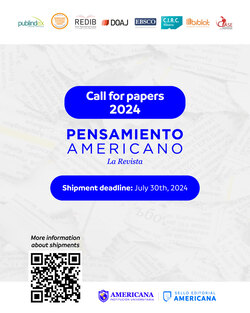Dinâmicas contemporâneas da mobilidade humana: uma revisão sistematizada
DOI:
https://doi.org/10.21803/penamer.17.34.726Palavras-chave:
Direitos civis, Ética, Livre circulaçãO, Migração, PrivacidadeResumo
Introdução: Tendo como pano de fundo a mobilidade humana contemporânea e o uso de tecnologias de informação e comunicação, este artigo aborda preocupações fundamentais, como a privacidade e o controle governamental de dados biométricos no campo da migração; Objetivo: analisar as implicações éticas, legais e sociais das ferramentas digitais na migração, destacando desafios e oportunidades, especialmente em relação à privacidade e à tomada de decisões orientadas por IA; Metodologia: Adotando uma abordagem qualitativa com metodologia documental e descritiva, foi realizada uma revisão sistemática da literatura, seguindo algumas das diretrizes PRISMA, para explorar a interseção entre tecnologia e migração a partir de várias perspectivas; Resultados: são revelados os desafios éticos na saúde dos migrantes, os riscos na tomada de decisões por IA, as questões legais em torno da vigilância biométrica e as preocupações com a privacidade na migração digital; Conclusões: Destaca a necessidade de enquadrar eticamente o uso de ferramentas digitais, garantindo a privacidade e os direitos dos migrantes e promovendo a colaboração genuína para apoiá-los em sua experiência de migração.
Downloads
Referências
References
Abomhara, M., Yayilgan, S.Y., Nymoen, A.H., Shalaginova, M., Székely, Z., & Elezaj, O. (2020). How to Do It Right: A Framework for Biometrics Supported Border Control. In: Katsikas, S., Zorkadis, V. (eds) E-Democracy – Safeguarding Democracy and Human Rights in the Digital Age. e-Democracy 2019. Springer. https://doi.org/10.1007/978-3-030-37545-4_7
Alejo, A. (2020). Migrant Diplomacy: Rethinking Civic Binationality in North America. Migrations. Publication of the University Institute for Migration Studies, (48), 105–131. https://doi.org/10.14422/mig.i48y2020.005
Alencar, A. (2017). Refugee integration and social media: a local and experiential perspective. Information Communication and Society, 21(11), 1588-1603. https://doi.org/10.1080/1369118x.2017.1340500
Almpani, S., Stefaneas, P., & Frangos, P. (2023). Formalization of ethical decision making. International Journal of Extreme Automation and Connectivity in Healthcare, 5(1), 1-13. https://doi.org/10.4018/ijeach.320488
Amelung, N., Granja, R., & Machado, H. (2021). A Brief History of the Evolution of Biometrics and Biometric Database Systems Crossing Borders in EU Law Enforcement. In: Modes of Bio-Bordering. Singapore. https://doi.org/10.1007/978-981-15-8183-0_2
Arévalo-Martínez, R. I., & del Prado Flores, R. (2021). International Organization for Migration Digital Communication: From Presence to Collaboration. Electronic Yearbook of Studies in Social Communication" Dissertations, 14(2), 1-25. https://doi.org/10.12804/revistas.urosario.edu.co/disertaciones/a.10389
Armijos Navarro, A. V., & Mejía Ama, J. R. (2023). Human Mobility: Risks and Protection Responses for the Population in a Situation of Human Mobility and Refuge in the Context of the COVID-19 Pandemic in Ecuador. Tsafiqui - Scientific Journal in Social Sciences, 13(20), 43-54. https://doi.org/10.29019/tsafiqui.v13i20.1138
Arthur, P. L., & Smith, I. (2022). Human journeys in the digital age: Advances and challenges in Digital Historical Migration Studies. Frontiers in Human Dynamics, 4, 915978. https://doi.org/10.3389/fhumd.2022.915978
Ávila, C., Higuera, M., & Soler, R. (2017). Critical reading. definitions, experiences and possibilities. Knowledge Science and Freedom, 12(2), 184-197. https://doi.org/10.18041/2382-3240/saber.2017v12n2.1586
Bentotahewa, V., Hewage, C., & Williams, J. (2021). Solutions to big data privacy and security challenges associated with COVID-19 surveillance systems. Frontiers in big Data, 4, 645204. https://doi.org/10.3389/fdata.2021.645204
Bivins, R. (2022). Forgone, not forgotten: "dna fingerprinting," migration control and britain's dna profiling pilot project. Science Technology and Human Values, 016224392211398. https://doi.org/10.1177/01622439221139877
Bucholtz, M., & Skapoulli, E. (2022). Introduction youth language at the intersection. Pragmatics Quarterly Publication of the International Pragmatics Association (Ipra), 19(1), 1-16. https://doi.org/10.1075/prag.19.1.01buc
Busso, M. (2023). Migrations, Mediatization and Digital Spaces: On the Configurations of Mobility in Research. Mediations, 30(19),142-154. https://doi.org/10.26620/uniminuto.mediaciones.19.30.2023.142-154
Cabalquinto, E., & Wood-Bradley, G. (2020). Migrant platformed subjectivity: rethinking the mediation of transnational affective economies via digital connectivity services. International Journal of Cultural Studies, 23(5), 787-802. https://doi.org/10.1177/1367877920918597
Cain, P., Daly, A., & Reid, A. (2021). How refugees experience the australian workplace: a comparative mixed methods study. International Journal of Environmental Research and Public Health, 18(8), 4023. https://doi.org/10.3390/ijerph18084023
Carrillo Gutierrez, P., & Díaz Argueta, J. C. (2023). Labour rights of irregular migrants. Justice, 28(44), 1–14. https://doi.org/10.17081/just.28.44.6713
Casas-Cortés, M., & Cobarrubias, S. (2020). The Autonomy of Migration: An Alternative Perspective on Human Mobility and Migration Controls. Empiria Journal of Social Science Methodology, (46), 65-92. https://doi.org/10.5944/empiria.46.2020.26967
Codina, L. (2020). How to conduct traditional or systematic literature reviews using academic databases. ENT Journal, 11(2), 139–153. https://doi.org/10.14201/orl.22977
Coronel Ayala, F. M., & López Sevilla, G. M. (2023). Mapping the current cybersecurity landscape in the modern digital age. RECIMUNDO, 7(2), 441-452. https://doi.org/10.26820/recimundo/7. (2).Jun.2023.441-452
Corte-Real, A., Nunes, T., & Cunha, P. (2022). Blockchain technology in migrant and refugee health: a scoping review. Journal of Global Health, 12. https://doi.org/10.7189/jogh.12.04047
Dekker, R., Engbersen, G., Klaver, J., & Vonk, H. (2018). Smart refugees: How Syrian asylum migrants use social media information in migration decision-making. Social Media+ Society, 4(1), 2056305118764439. https://doi.org/10.1177/2056305118764439
Domínguez-Amorós, M., & Suárez-Grimalt, L. (2022). Network Mobility: An Analysis of the Interrelationship between Social Mobility and Social Capital for Transnational Households of Brazilian Origin. Dice, 65(4), e20200355. https://doi.org/10.1590/dados.2022.65.4.272
Echauri, G., & Figueras-Maz, M. (2021a). Digital Interactions in a Transnational Context: Communicative Practices of International Students in Barcelona. Dixit, (35), 71-82. https://doi.org/10.22235/d35.2471
Echauri, G., & Figueras-Maz, M. (2021b). Temporary migration and use of social networks by international university students in Catalonia. Digital Work, (20). https://doi.org/10.25029/od.2021.307.20
Escofet, A. (2020). Service-learning and digital technologies: a possible relationship? Ried Ibero-American Journal of Distance Education, 23(1), 169-182. https://doi.org/10.5944/ried.23.1.24680
García-Saltos, C. D., & Márquez, J. A. (2022). Human mobility during the pandemic and its effects in Ecuador. International Journal of Social Science Research, 18(2), 265-284. https://doi.org/10.15359/rldh.34-1.8
Gomez Johnson, C. (2019). Fleeing in order not to die: human mobility in the context of sustained violence. The Mexican case. History and Graphy, (52), 57-95. http://www.scielo.org.mx/scielo.php?script=sci_arttextypid=S1405-09272019000100057ylng=esytlng=es.
Guan, H., Liye, D., & Zhao, A. (2022). Ethical risk factors and mechanisms in artificial intelligence decision making. Behavioral Sciences, 12(9), 343. https://doi.org/10.3390/bs12090343
Guillén de Romero, J. C., Menéndez Menéndez, F. G., & Moreira Chica, T. K. (2019). Migration: As a vulnerable social phenomenon and safeguard of human rights. Journal of Social Sciences, 25, 281-294. https://doi.org/10.31876/rcs.v25i1.29619
Huamani Huaranca, N. O., Huamani Huaranca, L. J., Pinto de Alarcón, J. A., & Cedeño Macías, A. M. (2023). ICT in Public Universities of Three Countries of the Andean Community of Nations during COVID-19. Comuni@cción: Journal of Communication and Development Research, 14(1), 41–54. https://doi.org/10.33595/2226-1478.14.1.805
Hurtado de Barrera, J. (2012). The Research Project: Holistic Understanding of Methodology and Research. Quiron Editions.
Kumar, B., Hargreaves, S., Agyemang, C., James, R., Blanchet, K., & Gruer, L. (2021). Reducing the impact of the coronavirus on disadvantaged migrants and ethnic minorities. European Journal of Public Health, 31(Supplement_4), iv9-iv13. https://doi.org/10.1093/eurpub/ckab151
Latonero, M., & Kift, P. (2018). On digital passages and borders: refugees and the new infrastructure for movement and control. Social Media + Society, 4(1), 205630511876443. https://doi.org/10.1177/2056305118764432
Leese, M., Noori, S., & Scheel, S. (2021). Data matters: the politics and practices of digital border and migration management. Geopolitics, 27(1), 5-25. https://doi.org/10.1080/14650045.2021.1940538
Leurs, K., & Ponzanesi, S. (2018). Connected migrants: Encapsulation and cosmopolitanization. Popular communication, 16(1), 4-20. https://doi.org/10.1080/15405702.2017.1418359
Leurs, K., & Smets, K. (2018). Five questions for digital migration studies: learning from digital connectivity and forced migration in(to) europe. Social Media + Society, 4(1), 205630511876442. https://doi.org/10.1177/2056305118764425
Loukinas, P. (2017). Surveillance and drones at greek borderzones: challenging human rights and democracy. Surveillance and Society, 15(3/4), 439-446. https://doi.org/10.24908/ss.v15i3/4.6613
Majeed, A., & Lee, S. (2020). Attribute susceptibility and entropy-based data anonymization to improve users' community privacy and utility in publishing data. Applied Intelligence, 50(8), 2555-2574. https://doi.org/10.1007/s10489-020-01656-w
Mantilla, J. (2022). Digital Solidarity and Migration: Analysis of the Use of Digital Technologies among Venezuelan Citizens in Quito, Ecuador. Border Studies, 23, e102. https://doi.org/10.21670/ref.2218102
Meissner, F., & Taylor, L. (2021). Migration information infrastructures: power, control and responsibility at a new frontier of migration research. https://doi.org/10.31235/osf.io/gkzmq
Merisalo, M., & Jauhiainen, J. (2020). Asylum-related migrants' social-media use, mobility decisions, and resilience. Journal of Immigrant and Refugee Studies, 19(2), 184-198. https://doi.org/10.1080/15562948.2020.1781991
Millán-Franco, M., Gómez-Jacinto, L., Hombrados-Mendieta, M. I., & García-Cid, A. (2019). Online and offline social support networks in immigrants from Malaga (Spain). Migrations. Publication of the University Institute of Migration Studies, (47), 119-149. https://doi.org/10.14422/mig.i47y2019.005
Mishra, V., & Mishra, M. P. (2023). PRISMA for Review of Management Literature – Method, Merits, and Limitations – An Academic Review. Vol. 2, 125-136. Emerald Publishing Limited. https://doi.org/10.1108/S2754-586520230000002007
Molnar, P. (2019). Technology on the margins: ai and global migration management from a human rights perspective. Cambridge International Law Journal, 8(2), 305-330. https://doi.org/10.4337/cilj.2019.02.07
Neag, A., & Supa, M. (2020). Emotional practices of unaccompanied refugee youth on social media. International Journal of Cultural Studies, 23(5), 766-786. https://doi.org/10.1177/1367877920929710
Nedelcu, M., & Soysüren, I. (2020). Precarious migrants, migration regimes and digital technologies: the empowerment-control nexus. Journal of Ethnic and Migration Studies, 48(8), 1821-1837. https://doi.org/10.1080/1369183x.2020.1796263
Neira Orjuela, F. (2023). Biometric Technologies in Latin American Migration: The Case of Chile, Colombia and Mexico. Center for Research on Latin America and the Caribbean: Ediciones Eón. http://www.librosoa.unam.mx/bitstream/handle/123456789/3658/9786073074803.pdf?sequence=1yisAllowed=y
Nesterova, I. (2022). Questioning the eu proposal for an artificial intelligence act: the need for prohibitions and a stricter approach to biometric surveillance. Information Polity, 27(2), 147-162. https://doi.org/10.3233/ip-211524
Nguyen, H., Baldassar, L., & Wilding, R. (2022). Lifecourse transitions: how icts support older migrants' adaptation to transnational lives. Social Inclusion, 10(4). https://doi.org/10.17645/si.v10i4.5735
Norval, A., & Prasopoulou, E. (2018). Seeing like a citizen: exploring public views of biometrics. Political Studies, 67(2), 367-387. https://doi.org/10.1177/0032321718766736
Ogáyar-Marín, F., Muntean, V., & Gamella-Mora, J. (2018). Digital Social Networks in Romania's Roma Transnational Migration. A transnational polymedia. Journal of the Humanities, (35), 107-136. https://doi.org/10.5944/rdh.35.2018.19813
Onarheim, K. H., Wickramage, K., Ingleby, D., Subramani, S., & Miljeteig, I. (2021). Adopting an ethical approach to migration health policy, practice and research. BMJ Global Health, 6(7), e006425. https://doi.org/10.1136/bmjgh-2021-006425
Ortiz Cobo, M., & Bianco, R. (2018). The use of ICTs in migratory processes: national and transnational communication. index. Communication, 8(2), 59–82. https://indexcomunicacion.es/index.php/indexcomunicacion/article/view/389
Pavez, I., Claro, C., & Suárez, J. A. B. (2020). The use of social networks in Colombian migrants in Chile. Sign and Thought, 39(76), 1-16. https://doi.org/10.11144/javeriana.syp39-76.ursm
Peña, S. (2019). Narratives of border reinforcement: The role of knowledge and communications. Border Studies, 20, e027. https://doi.org/10.21670/ref.1906027
Rodríguez Casallas, D. F., Páez Moreno, Ángel E., Román Acosta, D., & Rodríguez Torres, E. (2024). Citizen Participation, Democratic Governance and the Right to Development: A Systematic Review. Telos: Journal of Interdisciplinary Studies in Social Sciences, 26(1), 198-214. https://ojs.urbe.edu/index.php/telos/article/view/4529
Rodríguez Torres, E., Dávila Cisneros, J., & Gómez Cano, C. (2024). Training for the configuration of life projects: an experience through teaching-learning situations. Varona, (79). http://scielo.sld.cu/scielo.php?pid=S1992-82382024000100007&script=sci_abstract
Rodríguez Torres, E., López Gómez, H. E., & Dávila Cisneros, J. D. (2023b). Importance of student seedbeds in universities for scientific research. Negonotas Docentes, (22), 50-62. https://doi.org/10.52143/2346-1357.886
Rodríguez Torres, E., Pérez Gamboa, A. J., & Camejo Pérez, Y. (2023a). Distributed leadership education in the intervention in favor of the cultural heritage. Transformation, 19(2), 317-336. http://scielo.sld.cu/scielo.php?script=sci_arttext&pid=S2077-29552023000200317&lng=es&tlng=en
Rodríguez, M., & Cardozo, I. (2021). Level of critical reading in students of the Señor de Sipán University - modality work experience 2019 – ii. Maker - Aiapæc, 5(1), 1-15. https://doi.org/10.26495/rch.v5i1.1612
Roman-Acosta, D., Caira-Tovar, N., Rodríguez-Torres, E., & Pérez Gamboa, A. J. (2023). Effective leadership and communication strategies in disadvantaged contexts in the digital age. Health, Science and Technology - Lecture Series, 2, 532. https://doi.org/10.56294/sctconf2023532
Sadik, G., & Kaya, C. (2020). AB Göç Politikalarının ve Sınır Yönetiminin Güvenlikleştirilmesinde Gözetim Teknolojilerinin Rolü. Uluslararasi Iliskiler-International Relations, 17(68). https://doi.org/10.33458/uidergisi.856932
Sánchez Suárez, Y., Pérez Gamboa, A. J., Hernández Nariño, A., Díaz-Chieng, L. Y., Marqués León, M., Pancorbo Sandoval, J. A., & Rodríguez Torres, E. (2023). Hospital culture and social responsibility: a mixed study of the main lines for its development. Health, Science and Technology - Lecture Series, 2, 451. https://doi.org/10.56294/sctconf2023451
Sánchez-Querubín, N., & Rogers, R. (2018). Connected routes: Migration studies with digital devices and platforms. Social Media+ Society, 4(1), 2056305118764427. https://journals.sagepub.com/doi/pdf/10.1177/2056305118764427
Sandberg, M., & Rossi, L. (2021). Caring for (big) data: an introduction to research methodologies and ethical challenges in digital migration studies. Research methodologies and ethical challenges in digital migration studies. Palgrave Macmillan, Cham https://doi.org/10.1007/978-3-030-81226-3_1
Sun, W., & Yu, H. (2020). Wechatting the australian election: mandarin-speaking migrants and the teaching of new citizenship practices. Social Media + Society, 6(1). https://doi.org/10.1177/2056305120903441
Tjaden, J. (2021). Measuring migration 2.0: a review of digital data sources. Comparative Migration Studies, 9(1), 59. https://doi.org/10.1186/s40878-021-00273-x
Topak, Ö. E. (2019). Humanitarian and human rights surveillance: the challenge to border surveillance and invisibility? Surveillance and Society, 17(3/4), 382-404. https://doi.org/10.24908/ss.v17i3/4.10779
Ventevogel, P. (2018). Interventions for mental health and psychosocial support in complex humanitarian emergencies: moving towards consensus in policy and action? Mental Health of Refugee and Conflict-Affected Populations, 155-180. https://doi.org/10.1007/978-3-319-97046-2_8
Wang, X., Xiao, H., & Wang, B. (2014). Correlations and scaling laws in human mobility. Plos One, 9(1), e84954. https://doi.org/10.1371/journal.pone.0084954
Wienroth, M., & Amelung, N. (2023). Crisis', control and circulation: Biometric surveillance in the policing of the 'crimmigrant other. International Journal of Police Science and Management, 25(3), 297-312. https://doi.org/10.1177/14613557231184696
Downloads
Publicado
Versões
- 2024-09-12 (2)
- 2024-09-02 (1)
Edição
Seção
Licença
Copyright (c) 2024 Pensamiento Americano

Este trabalho está licenciado sob uma licença Creative Commons Attribution-NonCommercial-NoDerivatives 4.0 International License.
The author or authors of an article accepted for publication in the Journal Pensamiento Americano will transfer all of the patrimonial rights to the American University Corporation free of charge, within which are included: the right to edit, publish, reproduce and distribute both print media as digital, in addition to include in article in international indexes and / or databases, likewise, the Editorial Seal is authorized to use the images, tables and / or any graphic material presented in the article for the design of covers or posters from the same magazine. By assuming the patrimonial rights of the article, it may not be partially or totally reproduced in any printed or digital media without its express permission.
AUTHORITY ASPECTS
For the Pensamiento Americano Journal, all the authors of an article have made substantial contributions to the research and the manuscript, and they share the responsibility when the article presents errors, fraud in some way or violations of copyright.
After submitting an article, the journal does not accept the addition, deletion or change in the order of the authors, in addition we reserve the right to release the article when it has been submitted to the journal and under no circumstances will American Thought accept the article. withdrawal of an article during any phase of the editorial process






